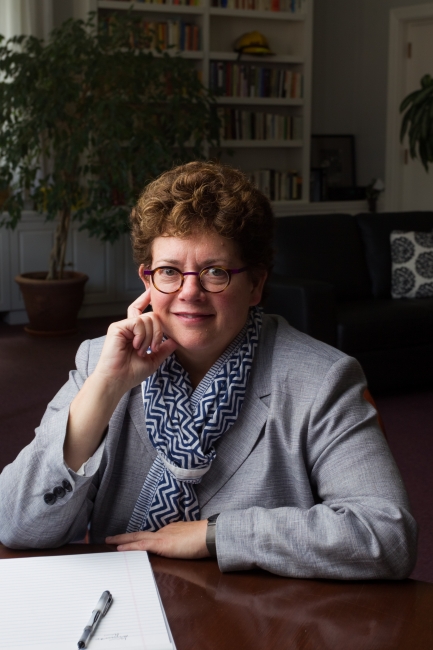You have /5 articles left.
Sign up for a free account or log in.

Biddy Martin is the president of Amherst College, which received the Cooke Prize for Equity in Educational Excellence.
Amherst College
At a time when many highly selective colleges are looking for ways to enroll more low-income students, Amherst College President Carolyn (Biddy) Martin often finds herself discussing the issues that can stem from diversity on the campus of an elite higher education institution.
“Conversations are as focused -- not more, but as focused -- on the challenges and opportunities once a diverse student body has actually chosen to come,” she said.
Martin is in a place to talk about those challenges and opportunities after Amherst, a liberal arts college in western Massachusetts with nearly 1,800 students, spent years building a track record of reaching out to low-income students. The track record doesn’t start with Martin, who was elected Amherst’s 19th president in 2011. She’s quick to say it goes back to her predecessor, Anthony Marx, who made low-income students a priority.
Still, Martin has continued and expanded efforts. On Monday, she discussed them with Inside Higher Ed after Amherst was named the recipient of the $1 million Cooke Prize for Equity in Educational Excellence from the Jack Kent Cooke Foundation. The foundation gives that award to a selective college or university demonstrating a record of admitting, supporting and graduating low-income students. The foundation began giving the award last year, making Vassar College in New York the first recipient.
Amherst’s record includes specific efforts, like funding for low-income students to study abroad. The college also provides stipends to help with career mentoring and internships that are unpaid. A majority of Amherst’s students, 58 percent, receive need-based aid. It does not provide merit aid, and it follows a need-blind admissions process while having a no-loan policy for financial aid recipients.
The college has increased the proportion of federal Pell Grant recipients among its students from 15 percent in 2006-7 to almost 25 percent this academic year. At the same time, it has raised the number of community college students transferring in from virtually none to 12 to 15 per year.
The average financial aid package in 2015-16 was more than $50,000 per student for a college where tuition, fees, and room and board were listed at nearly $63,000.
Amherst has a substantial endowment of $2.2 billion to draw upon in its effort. Money could be a challenge for some institutions trying to support low-income students. But today, most elite colleges and universities know what strategies work on their campuses for students who are not wealthy, Martin said.
She is more engaged with peers, she said, on the things that challenge those students once they’re on campus. Challenges can include money preventing a student from taking an unpaid internship or policies that heavily impact low-income students. For instance, a student receiving a D or an F at Amherst cannot repeat that same course at the college but can do so at another institution at their own expense.
Amherst is still, however, important in the conversation about bringing low-income students to selective campuses. Martin said Amherst should have more students transferring from community colleges. She predicts it will continue to raise its transfer levels, and that the increase will help the college.
“The notion that the students are only contributing to or benefiting from the Amherst culture if they’re only there for four years is simply not the case,” Martin said.
“It’s a giant benefit to the college,” she said. “I’ve talked about the social and academic benefits, but it’s also an enrollment benefit.”
Talk of increasing low-income students at Amherst led to talk of diversity. That discussion brought up a sit-in students staged at the campus library in November, protesting racial discrimination at Amherst and other institutions. Participating students presented a list of 11 demands to the college’s administration, drawing national attention in the process.
Regardless of any outside debate or criticism, Martin said the events were positive for Amherst because they encouraged those on campus to listen to each others’ stories.
“I think it broke some silos, it eased some tensions that were there and would be there, inevitably, and it allowed people to listen to one another,” Martin said. “It also allowed people who didn’t agree, especially, with the initial demands that students made to find ways to speak up in disagreement, either in classrooms or dorms or residence halls and, over time, a wider variety of opinions about what had occurred became clear.”
Amherst plans to use money from the Cooke Foundation’s prize to fund summer programs for low-income students. Programs will include research with faculty members, internships and arts training. The college will also use the money to help fund financial aid peer advisers for transfer and first-generation students.
The Cooke Foundation argues most elite institutions can do more to attract and aid low-income students. The foundation performed a study released in January finding that just 3 percent of students at top U.S. colleges come from the poorest quartile of families. Meanwhile, 72 percent come from the wealthiest quartile.
“There’s so much more that can be done,” said Cooke Foundation Executive Director Harold O. Levy. “If you look at the data on the number of kids who are Pell eligible in these institutions, it’s flat for 15 years. And then there are a couple of standout examples like Amherst, like Vassar, like some of the finalists for this award. They’ve stepped up, they are changing their ways, but the vast majority of these elite institutions are nowhere, and that’s depressing.”
Other finalists for the Cooke Prize this year were Davidson College, in North Carolina; Pomona College, in California; Rice University, in Texas; and Stanford University, in California.




